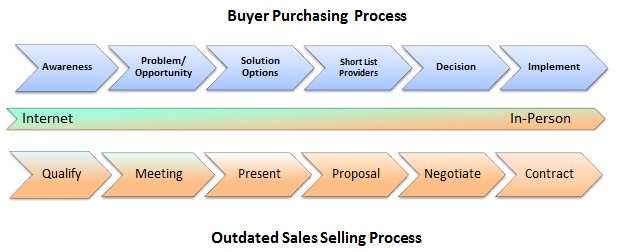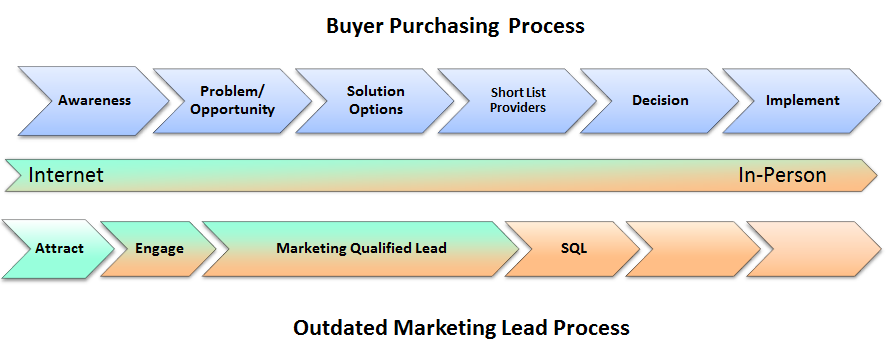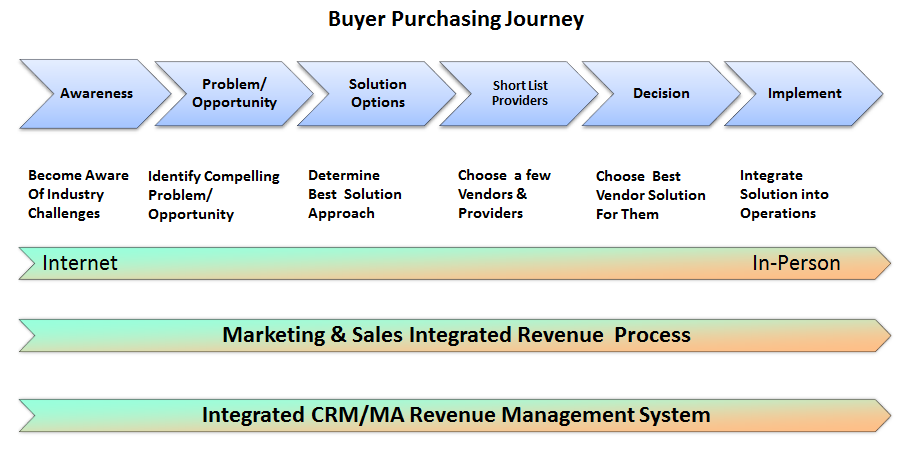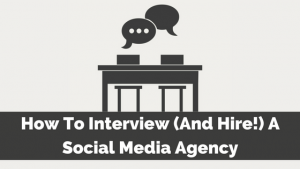
Competing for business against a much larger organization has always been challenging.
However, with the recent changes in buyer behavior, and increased adoption of automation technology, small and medium-sized businesses (SMB) have a unique window of opportunity; a potential competitive advantage in sales and marketing.
Executives in smaller companies tend to be more hands-on and demonstrate a deeper understanding of their operations.
This insight can be turned into a competitive advantage.
To better understand the competitive opportunity for SMB, let’s first take a look at the challenges that large companies are currently facing.
The New Buyer Journey
Compared to a few years ago, B2B buyers now have unprecedented online access to industry, company and product information via their smartphone or PC. They are actively consuming information from digital sources: from internet search, from various websites, from various social platforms, from advertised and promoted content, from blogs and articles, via their smartphone, via their desktop, whenever and wherever they want.

What does that really mean for businesses? These self-educating buyers are completing up to 70% of their purchasing process without engaging a vendor Sales organization.
Before you even meet with a prospect, they are probably already predisposed toward a solution and small set of vendors that they, or members of their buyer team, have learned about online. They probably know more about your competitor’s solution than you know about your prospect’s business challenges!
The Challenge For Larger Companies
The large B2B companies invested in Marketing Automation and started to generate hundreds of online leads for their Sales organizations. Unfortunately, the majority of these leads are of poor quality and ignored by Sales.
To fix the issue of poor quality leads, companies started to talk about Marketing and Sales alignment, so much so that they’ve created their own book of 3 letter acronyms: MQL (Marketing Qualified Lead), SQL (Sales Qualified Leads), Sales Rejected Lead (SRL), Service Level Agreement (SLA), Sales Accepted Lead (SAL), ad nausea.
What does this have to do with the new buyer journey? Unfortunately, nothing.This alignment initiative is really in response to the needs of their Marketing Automation machine rather than the needs of the new self-educating buyer.
When you dig deeper, you quickly figure out the real root cause of the big company challenge: they can’t get their arms around their revenue process:
1/ Too Big To Make Operational Changes? Big companies have multiple large silos/functions, each with so much momentum that it’s extremely difficult for them to change direction quickly, particularly regarding cross-functional process.

- The Sales Process is still based upon in-person, internally-focused Sales actions like meet, present and negotiate. This worked well 10 years ago when customers initiated their purchasing journey by requesting a meeting with the local vendor. Sales controlled access to most of the information, so they controlled the journey. Today, most members of the B2B buyer teams are self-educating themselves online, so it’s no longer reliable to determine the buyer’s purchasing stage through the actions of the sales rep alone.

- The Marketing process is still based upon internal Marketing actions like attract, engage and nurture. Unfortunately, Marketing generated leads were never of high value for the Sales force, even during the heyday of huge tradeshows and T-shirt giveaways. The leads do not provide Sales with enough information to determine if the prospect is really a potential buyer of the company’s products and services. However, with Marketing Automation generating hundreds of these leads each month, it’s becoming a more important problem to solve.
- The Marketing process and Sales processes are totally different, and neither one is sufficiently aligned to the company’s target buyer and their purchasing process.
2/ Too big to empower cross-silo/function teamwork? Big companies have a difficult time managing customer experience throughout the buyer journey. With multiple individuals and groups from multiple silos, the customer experience is fragmented.
- Marketing creates a lead, Sales closes the lead, so alignment efforts have been focused internally to hand off a “lead” as fast as possible between functions, like a relay team, rather than focused externally to better align with the new buyer purchasing process.
- The Marketing Process is focused on buyer engagement and branding, the Sales Process is focused on buyer interaction and sales closure, and neither are facilitating the buyer throughout their online/offline/ online purchasing journey.
- Marketing has their Marketing Automation, Sales has their CRM System, but the company has no common revenue generation and management system. What is the ROI of Marketing? Is the cost of sales too high? Why is the company missing its growth goals?
Small and medium-sized businesses, because of their smaller size and availability of low-cost automation technologies, can solve these issues more quickly than larger companies.
The Revenue Growth Opportunity For SMBs
A smaller organization has the inherent ability to implement change much more quickly than a larger organization. They don’t have multiple Marketing groups, multiple sales organizations, myriad technologies, and all the politics and bureaucracy that go along with implementing change within a larger company.
Equally important, by taking action today, you’ll start to pull ahead of your peer competitors.
To take full advantage of this opportunity, the SMB has to accomplish these 4 steps.
- Align the company to your Buyer Purchasing Journey. Your Marketing and Sales groups need to update their internally-focused processes and focus on the needs of the Buyer throughout their online/offline/online purchasing journey. The company needs to have one, and only one, perspective of the buyer that all functions/groups (including Product Management, Customer Service and Finance) can embrace and deliver a consistent customer experience.
- Facilitate your Buyer Journey. Your Marketing and Sales groups need to embrace an integrated revenue process that is designed to directly help the buyer move through their purchasing journey expeditiously, with a predisposition for your company products and services. With Marketing contributing its expertise in one-to-many communication techniques, and Sales contributing its expertise in one-to-one communication techniques, together they can facilitate a cost effective, revenue generation team.
- Leverage proven Marketing and Sales Technologies. Leverage cost-effective technologies to create an integrated revenue system to generate, manage and close high quality leads at low cost. Implement a fully integrated Marketing Automation/CRM solution from Infusionsoft, Hubspot and others for as little as $ 199 per month. (Smaller organizations can implement simple email automation with auto-responders from Aweber, Constant Contact and others for as little as $ 15 per month).
- Empower cross-functional teamwork. Marketing and Sales specialists need to work more like members of a high-performance basketball team, adding value with each customer interaction throughout their journey, rather than a relay team focused on handing off leads internally. As part of their online purchasing journey, the buyer may benefit from a quick online chat with a product specialist before continuing their self-educating journey, or a quick online demo with a support specialist, or a quick online call with an inside sales specialist regarding price clarification.

The SMB Next Steps
The solution is not as complicated as it may first appear. Successful companies must always understand and facilitate their buyer’s purchasing process. They need to always leverage proven, cost-effective technologies to continually facilitate a lower cost of sales. They need to always empower teamwork.
It’s just that things are changing in the marketplace faster than most companies fully appreciate.
The buyer journey will continue to evolve, so you need a solution that can keep up. An experienced Marketing and Sales consultant can help you quickly align your operations to the current buyer journey, while setting the stage for implementation of a dynamic revenue process and real-time revenue management system to maintain alignment between your company functions and your buyer going forward. See Marketing and Sales: Alignment, Integration or Collaboration for additional insight.
The sooner you start to better align with your customer, the sooner you will start benefiting from higher revenue growth rates and profit margins.
Let’s take the advantage. Please share this with your colleagues to continue the discussion.
(316)
Report Post






